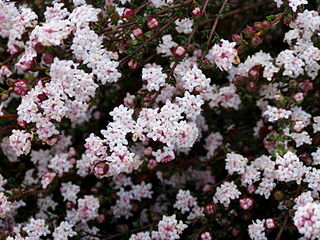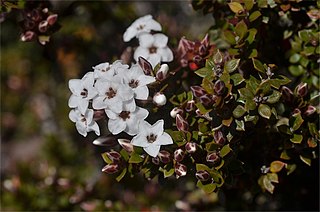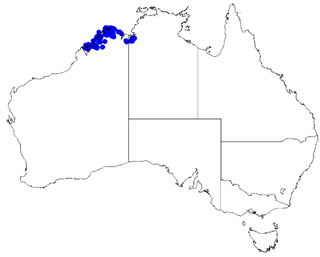
Lasiopetalum floribundum, commonly known as free flowering lasiopetalum, is a species of flowering plant in the family Malvaceae and is endemic to the south-west of Western Australia. It is an erect or spreading shrub with hairy young stems, egg-shaped leaves and pale pink, mauve or white flowers.

Persoonia confertiflora, commonly known as cluster-flower geebung, is a species of flowering plant in the family Proteaceae and is endemic to south-eastern Australia. It is an erect to low-lying shrub with hairy young branches, egg-shaped to narrow elliptic leaves, and hairy yellow flowers borne on leaf axils or on the ends of short branches.

Epacris reclinata, commonly known as fuchsia heath, is a species of flowering plant in the family Ericaceae and is endemic to eastern New South Wales. It is a low-lying to spreading shrub with egg-shaped leaves and pink to red, tube-shaped flowers, sometimes with lighter tips.

Seringia hillii is a species of flowering plant in the mallow family and is endemic to eastern Australia. It is a single-stemmed shrub with hairy new growth, egg-shaped leaves and usually mauve flowers arranged in groups of 2 to 9.

Pimelea brachyphylla is a species of flowering plant in the family Thymelaeaceae and is endemic to the south-west of Western Australia. It is an erect to spreading shrub with linear to elliptic leaves and clusters of white, tube-shaped flowers.

Epacris serpyllifoliais a species of flowering plant in the heath family Ericaceae and is endemic to Tasmania. It is a small low-lying or weakly erect shrub with heart-shaped to broadly egg-shaped leaves and tube-shaped white flowers crowded in upper leaf axils.

Grevillea muelleri is a species of flowering plant in the family Proteaceae and is endemic to the a relatively small area of south-western Western Australia. It is a shrub with linear to narrowly oblong, or divided leaves with linear or narrowly egg-shaped lobes, more or less spherical clusters of white to cream-coloured flowers.

Agonis baxteri is a species of flowering plant in the family Myrtaceae and is endemic to the southwest of Western Australia. It is an erect, sometimes bushy shrub with elliptic to egg-shaped leaves with the narrower end towards the base, and usually white flowers with 23 to 32 stamens.

Petrophile semifurcata is a species of flowering plant in the family Proteaceae and is endemic to an area near the west coast of Western Australia. It is an erect, bushy shrub with sharply-pointed, needle-shaped, sometimes lobed leaves and oval heads of silky-hairy, whitish, lemon-yellow or cream-coloured flowers.

Epacris calvertiana is a plant of the heath family, Ericaceae and is endemic to New South Wales. It is an erect to diffuse shrub with elliptic to egg-shaped leaves with a sharp-pointed tip and with white, pink or red flowers arranged along the ends of leafy branchlets.

Olearia iodochroa, commonly known as the violet daisy bush, is a species of flowering plant in the family Asteraceae and is endemic to south-eastern continental Australia. It is a shrub with branchlets densely covered with whitish hairs, narrowly egg-shaped leaves with the narrower end towards the base, and white or mauve, and cream-coloured, yellow or blue, daisy-like inflorescences.

Boronia wilsonii is an erect shrub that is endemic to northern Australia. Its branches, leaves and backs of the flowers are densely covered with woolly hairs. The petals are white to pink or burgundy-coloured.

Phebalium obcordatum, commonly known as the club-leaved phebalium, is a species of shrub that is endemic to New South Wales. It has smooth branchlets, small egg-shaped to heart-shaped leaves with the narrower end towards the base and small umbels of pale yellow flowers with silvery scales on the back of the petals.
Hibbertia juncea is a species of flowering plant in the family Dilleniaceae and is endemic to the Northern Territory. It is a small shrub with leaves reduced to minute scales, and white to cream-coloured or pink flowers arranged in leaf axils with seven to ten stamens.

Bossiaea dentata is a species of flowering plant in the family Fabaceae and is endemic to the south of Western Australia. It is an erect, sometimes prostrate shrub with variably-shaped leaves and greenish-yellow or pink to burgundy-coloured flowers.

Olearia exiguifolia commonly known as small-leaved daisy bush, is a species of flowering plant in the family Asteraceae and is endemic to south-western Australia. It is an erect or straggly shrub with broadly egg-shaped leaves with the narrower end towards the base, and white and yellow, daisy-like inflorescences.
Pomaderris clivicola is a species of flowering plant in the family Rhamnaceae and is endemic to a restricted area of Queensland. It is a multi-stemmed shrub with softly-hairy twigs, egg-shaped leaves, and small panicles of yellow to cream-coloured flowers.

Lasiopetalum drummondii is a species of flowering plant in the family Malvaceae and is endemic to the south-west of Western Australia. It is an erect, slender shrub with many densely hairy stems, egg-shaped or oblong leaves and white, pink and red flowers.
Lasiopetalum laxiflorum is a species of flowering plant in the family Malvaceae and is endemic to the south-west of Western Australia. It is a sticky, straggling subshrub or shrub with many densely hairy stems, egg-shaped leaves, and bright pink and dark red flowers.

Abutilon cryptopetalum is a flowering plant in the family Malvaceae. It is a small, upright shrub with yellow or cream-white flowers and variable shaped grey-green leaves and grows in New South Wales, South Australia, Western Australia and the Northern Territory.


















